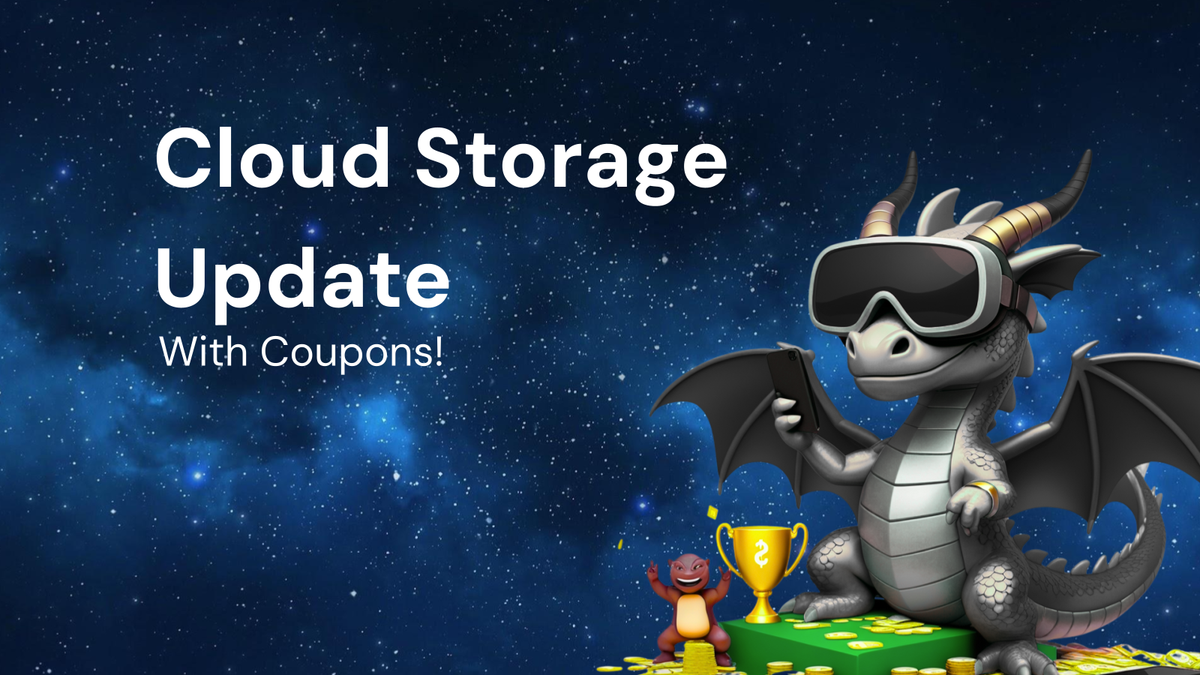Monthly Update for cloud storage with coupons

Monthly Update for Cloud Storage with Coupons
The world of cloud storage is constantly evolving. New features are rolled out, pricing plans are adjusted, and competition continues to drive innovation. Keeping up with these changes can be overwhelming. That's why we've created this monthly update, a one-stop resource for staying informed about the latest developments in cloud storage. We'll delve into recent updates from leading providers, highlight useful tips and tricks for maximizing your storage, and, of course, point you towards valuable coupons and discounts to help you save money. Think of this as your compass, guiding you through the ever-expanding landscape of cloud storage. We're not selling anything, just providing information to help you make informed decisions.
1. Recent News & Updates from Major Cloud Storage Providers
This section will keep you abreast of the most significant announcements and feature releases from prominent players in the cloud storage arena. We’ll focus on practical implications and potential benefits for users, avoiding hype and concentrating on facts.
1.1 Google Drive:
- Contextual Search Enhancements: Google has recently improved its search functionality within Google Drive, leveraging AI to understand context and relationships between files. This means you can now search for documents using more natural language queries. For example, instead of searching "Project Proposal v3," you might be able to search "proposal I sent John last week about project X."
- Search Instruction: To utilize this feature, simply type your search query into the Google Drive search bar as you normally would. Google will automatically analyze your query and attempt to find relevant files based on context.
- Tips: Provide as much detail as possible in your search query. Including dates, names, and keywords related to the file content can significantly improve search accuracy. Experiment with different phrasing to see what yields the best results.
- Integration with Gemini AI: Google is increasingly integrating Gemini AI into its Workspace suite, including Google Drive. This is beginning to manifest in features like automated summaries of documents and the ability to generate content directly within Google Docs.
- Search Instruction: While direct AI integration is still rolling out, keep an eye out for the "Help me write" feature in Google Docs and the ability to generate summaries of Google Drive files. These features typically appear as suggestions within the user interface.
- Tips: Be mindful of the limitations of AI-generated content. Always review and edit AI-generated summaries and content to ensure accuracy and clarity.
1.2 Microsoft OneDrive:
- Advanced Version History: Microsoft OneDrive has refined its version history feature, allowing users to restore previous versions of files with greater precision. You can now preview individual changes made in each version before restoring.
- Search Instruction: Right-click on a file in OneDrive and select "Version history." A panel will appear showing all previous versions of the file. You can then click on each version to preview it.
- Tips: Use version history proactively to protect against accidental deletions or unwanted changes. Regularly back up important files to ensure you have multiple recovery points.
- Enhanced Collaboration Features: OneDrive has introduced improvements to its collaborative editing tools, including more robust commenting and real-time co-authoring capabilities.
- Search Instruction: When sharing a file in OneDrive, select the option to "Allow editing." This will enable real-time co-authoring. You can then add comments and track changes within the document.
- Tips: Utilize the @mention feature to directly notify specific collaborators about comments or tasks. Clearly define roles and responsibilities for each collaborator to avoid confusion.
1.3 Dropbox:
- Dropbox AI (Early Access): Dropbox is investing heavily in AI, launching a beta program for "Dropbox AI." This feature aims to help users summarize documents, answer questions based on file content, and generate new content.
- Search Instruction: Access to Dropbox AI is currently limited to beta users. If you're enrolled in the beta program, you'll find the AI features integrated within the Dropbox interface, typically accessible when viewing or interacting with files.
- Tips: Consider applying for the Dropbox AI beta program to gain early access to these new features. Be prepared to provide feedback to Dropbox to help them improve the AI's performance.
- Dropbox Dash: Dropbox Dash is a unified search and organization tool designed to help users find files across multiple cloud services, not just Dropbox. This feature aggregates search results from various sources, streamlining the process of finding specific documents.
- Search Instruction: Dropbox Dash allows you to connect multiple cloud services. Once connected, use the Dash search bar to search across all your connected accounts simultaneously.
- Tips: Take advantage of Dropbox Dash's ability to create collections and organize files from different services into a single, easily accessible location.
1.4 Other Providers:
- Keep an eye on announcements from other providers like pCloud, Box, and Backblaze B2. These providers often offer specialized features or pricing models that may be attractive depending on your needs. Their updates often focus on security, performance, and niche applications.
2. Mastering Your Cloud Storage: Tips & Tricks
Beyond the headline features, subtle tweaks and smart workflows can significantly enhance your cloud storage experience. These tips will help you use your chosen service more efficiently.
2.1 Effective File Organization:
- Consistent Naming Conventions: Establish a clear and consistent naming convention for your files. Use descriptive names that include relevant keywords, dates, and version numbers. This makes it easier to find files and understand their contents at a glance.
- Search Instruction: When naming files, use keywords that are relevant to the file's content. For example, instead of "Document1.docx," use "Project-Alpha-Report-Final-2024-08-15.docx."
- Tips: Avoid using generic names like "Untitled Document." Use dates in the YYYY-MM-DD format to ensure consistent sorting.
- Folder Hierarchy: Create a well-organized folder hierarchy that reflects your workflow. Group related files into folders and subfolders. Avoid having too many files in a single folder, as this can make it difficult to find what you're looking for.
- Search Instruction: When creating folders, think about how you naturally categorize your files. For example, you might create folders for different projects, clients, or departments.
- Tips: Limit the depth of your folder hierarchy to avoid excessive clicking. Consider using color-coding to visually distinguish between different types of folders.
- Tagging and Metadata: Utilize tagging and metadata features (if available) to add extra information to your files. This can make it easier to search for files based on criteria other than filename.
- Search Instruction: The process for adding tags and metadata varies depending on the cloud storage provider. Look for options to add custom attributes to your files.
- Tips: Use tags consistently across all your files. Consider using a controlled vocabulary for tags to ensure uniformity.
2.2 Optimizing Storage Space:
- Identify and Delete Duplicate Files: Regularly scan your cloud storage for duplicate files. These can accumulate quickly and consume valuable space. Most cloud storage services offer built-in tools or third-party apps to help you identify and remove duplicates.
- Search Instruction: Search your cloud storage for files with identical names and sizes. Use third-party duplicate file finders for more comprehensive scanning.
- Tips: Before deleting any files, make sure you have a backup. Exercise caution when deleting files that appear to be duplicates, as they may contain subtle differences.
- Compress Large Files: Compress large files, such as images and videos, to reduce their size. This can save storage space and improve upload/download speeds.
- Search Instruction: Use compression tools like ZIP or RAR to reduce file sizes. Experiment with different compression levels to find the optimal balance between size and quality.
- Tips: Consider using lossless compression formats to minimize data loss. Be aware that compressing files can take time and resources.
- Leverage Archiving: Archive older or less frequently accessed files to free up space in your primary storage. Many cloud storage providers offer archiving options that move files to lower-cost storage tiers.
- Search Instruction: Check your cloud storage provider's documentation for instructions on archiving files. The process typically involves moving files to a designated archive folder or storage tier.
- Tips: Clearly label archived files so you know when they were archived and what they contain. Consider using a separate archiving service for long-term storage.
2.3 Enhancing Security:
- Enable Two-Factor Authentication (2FA): Protect your account with two-factor authentication. This adds an extra layer of security by requiring a second code (usually sent to your phone) in addition to your password.
- Search Instruction: Go to your cloud storage account's security settings and enable two-factor authentication. Follow the prompts to set up your preferred authentication method.
- Tips: Use an authenticator app like Google Authenticator or Authy for the most secure 2FA experience. Keep your recovery codes in a safe place in case you lose access to your primary authentication method.
- Use Strong Passwords: Use strong, unique passwords for your cloud storage account and all associated accounts. Avoid using easily guessable passwords like your name or birthday.
- Search Instruction: Use a password manager to generate and store strong, unique passwords. Avoid reusing passwords across multiple accounts.
- Tips: Use a combination of uppercase and lowercase letters, numbers, and symbols in your passwords. Change your passwords regularly to maintain security.
- Control Sharing Permissions: Be careful when sharing files with others. Grant only the necessary permissions and avoid sharing sensitive information unnecessarily.
- Search Instruction: When sharing a file, carefully review the sharing options. Choose the appropriate level of access (e.g., view-only, comment-only, edit access).
- Tips: Use expiration dates for shared links to automatically revoke access after a certain period. Consider using password protection for sensitive files.
- Regularly Review Account Activity: Monitor your account activity for any suspicious logins or file access attempts. Most cloud storage providers provide an activity log that shows recent account activity.
- Search Instruction: Go to your cloud storage account's security settings and review the activity log. Look for any unfamiliar IP addresses or login attempts.
- Tips: Set up email alerts for suspicious activity. Immediately report any unauthorized access to your cloud storage provider.
3. Finding the Best Cloud Storage Deals: Coupons and Discounts
Now, let's get to the exciting part – saving money! Cloud storage providers frequently offer discounts and coupons to attract new customers and retain existing ones. Here's how to find the best deals:
3.1 Where to Look for Coupons:
- Official Website and Newsletters: Start by checking the official website of your preferred cloud storage provider. Many providers list current promotions and discounts directly on their website. Sign up for their email newsletter to receive exclusive deals and announcements.
- Search Instruction: Navigate to the "Pricing" or "Promotions" section of the cloud storage provider's website. Look for a link to sign up for their email newsletter.
- Tips: Check your spam folder if you don't receive the newsletter in your inbox. Be wary of phishing emails that impersonate cloud storage providers.
- Coupon Websites: Numerous websites aggregate coupons and deals from various online retailers, including cloud storage providers. Popular coupon websites include RetailMeNot, Coupons.com, and Groupon.
- Search Instruction: Search for the name of your preferred cloud storage provider on these coupon websites.
- Tips: Read the terms and conditions of each coupon carefully before using it. Make sure the coupon is valid and applicable to your desired plan.
- Affiliate Websites and Blogs: Many websites and blogs that review cloud storage services also offer exclusive coupons and discounts to their readers. Look for affiliate links or coupon codes within the review articles.
- Search Instruction: Search for reviews of your preferred cloud storage provider on Google. Look for affiliate links or coupon codes within the review articles.
- Tips: Be aware that affiliate websites may earn a commission if you use their links to purchase a cloud storage plan. This doesn't necessarily mean the deal is not legitimate, but it's important to be aware of the potential bias.
- Social Media: Follow your preferred cloud storage providers on social media platforms like Facebook, Twitter, and LinkedIn. Many providers announce exclusive deals and promotions to their social media followers.
- Search Instruction: Search for your preferred cloud storage provider on social media. Follow their official accounts to receive updates and announcements.
- Tips: Enable notifications from your cloud storage provider's social media accounts to avoid missing out on deals.
3.2 Types of Coupons and Discounts:
- Introductory Offers: Many cloud storage providers offer discounted pricing for new customers for a limited time. These introductory offers can be a great way to try out a service before committing to a long-term plan.
- Student Discounts: Some cloud storage providers offer discounts to students enrolled in accredited educational institutions. You may need to provide proof of enrollment to qualify for the discount.
- Non-Profit Discounts: Some cloud storage providers offer discounts to non-profit organizations. You may need to provide proof of non-profit status to qualify for the discount.
- Referral Programs: Many cloud storage providers offer referral programs that reward you for referring new customers. You and your referral may both receive a discount or bonus storage.
- Bundled Deals: Some cloud storage providers offer bundled deals that include other services, such as VPNs or productivity software. These bundles can offer significant savings compared to purchasing the services separately.
- Seasonal Sales: Cloud storage providers often offer discounts during seasonal sales events, such as Black Friday, Cyber Monday, and back-to-school sales.
3.3 Important Considerations When Using Coupons:
- Read the Fine Print: Carefully read the terms and conditions of any coupon or discount before using it. Pay attention to expiration dates, eligibility requirements, and any other restrictions.
- Check Compatibility: Make sure the coupon is compatible with your desired plan. Some coupons may only be valid for specific plans or storage tiers.
- Compare Prices: Compare the discounted price with the regular price and with prices from other cloud storage providers. Make sure you're getting a good deal.
- Be Wary of Scams: Be wary of fake coupons or scams. Never provide your personal information or payment details to untrusted websites. Always verify the legitimacy of a coupon before using it.
4. Choosing the Right Cloud Storage for Your Needs
With so many options available, selecting the right cloud storage provider can feel daunting. Here's a framework to help you narrow down your choices:
4.1 Assess Your Storage Needs:
- How much storage do you need? Estimate the amount of storage you currently use and the amount you anticipate needing in the future. Consider the types of files you'll be storing (e.g., documents, photos, videos) and their average size.
- What types of files will you be storing? Some cloud storage providers are better suited for storing specific types of files. For example, if you plan to store a lot of photos and videos, you'll want to choose a provider with good multimedia support.
- How often will you be accessing your files? If you need to access your files frequently, you'll want to choose a provider with fast upload and download speeds.
- Do you need to collaborate with others? If you need to collaborate with others on your files, you'll want to choose a provider with good collaboration features.
4.2 Consider Your Budget:
- What is your budget for cloud storage? Cloud storage prices vary widely. Consider how much you're willing to spend on cloud storage each month or year.
- Are you willing to pay for additional features? Some cloud storage providers offer additional features, such as advanced security options or collaboration tools, for an extra fee.
- Do you need a specific billing cycle? Some cloud storage providers offer monthly or annual billing cycles. Choose the billing cycle that best suits your needs.
4.3 Evaluate Key Features:
- Security: Choose a provider with strong security measures, such as encryption, two-factor authentication, and data loss prevention.
- Reliability: Choose a provider with a good track record of uptime and data durability.
- Performance: Choose a provider with fast upload and download speeds.
- Usability: Choose a provider with a user-friendly interface and easy-to-use features.
- Collaboration: Choose a provider with good collaboration features, such as real-time co-editing, commenting, and version control.
- Integration: Choose a provider that integrates well with your existing tools and workflows.
4.4 Read Reviews and Compare Providers:
- Read reviews from independent sources to get an unbiased opinion of different cloud storage providers.
- Compare the features and pricing of different providers to find the best option for your needs.
- Take advantage of free trials to test out different providers before committing to a paid plan.
5. Staying Informed: Resources and Further Reading
The cloud storage landscape is constantly changing. Here are some resources to help you stay informed about the latest developments:
- Cloud Storage Provider Blogs: Follow the blogs of your preferred cloud storage providers to stay up-to-date on new features, promotions, and industry news.
- Tech News Websites: Read tech news websites like TechCrunch, The Verge, and Wired to stay informed about the latest developments in cloud storage and technology in general.
- Cloud Storage Comparison Websites: Use cloud storage comparison websites like Cloudwards.net and Best Cloud Storage to compare the features and pricing of different providers.
- Online Forums and Communities: Participate in online forums and communities dedicated to cloud storage to share tips, ask questions, and learn from other users.
By staying informed and following these tips, you can make the most of your cloud storage and keep your data safe and accessible. Remember to continually evaluate your storage needs and explore new options as the cloud storage landscape evolves. Good luck!




